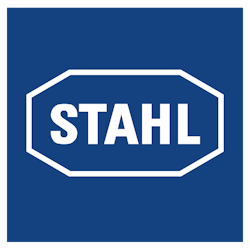As with any industrial network project, understanding users’ underlying needs for Ethernet-APL is crucial to determining how to design it and what technologies and training will be required.
“In the past, Ethernet for hazardous areas typically used fiber-optic lines, which had the advantage of speed, data capacity in the hundreds of megabytes to gigabyte range, and protection against electromagnetic interference (EMI). However, it also had disadvantages due to installation difficulties, costly cabling, and the inability to provide power, which meant it had to come from elsewhere,” says Andre Fritsch, senior product manager for remote I/O, fieldbus and Ethernet at R. Stahl. “This is why the four standards organizations (SDO) and their 12 industry partners sought to globally standardize a copper-based Ethernet for hazardous areas, established the Ethernet-APL organization in 2018-19. Its original core requirements were: providing electricity via Ethernet, though different than the Power over Ethernet (PoE) method; connectivity with two-wire copper; longer distance of 1,000 meters; and enabling process automation in hazardous location with the support of intrinsic safety (IS) in accordance with the IEC 60079-11 standard. Ethernet-APL is just two-wire Ethernet with explosion protection on top.”
Got cables?
To implement Ethernet-APL, R. Stahl’s Fritsch reports there are several questions users need to ask. First, if they’re implementing a greenfield application, they can go with any suitable Ethernet-APL option because they’re buying new cable. However, if it’s a brownfield application, they need to determine if they can reuse their existing cable, and if so, how much?
“If the user already has Profibus or Foundation Fieldbus in place, they can likely reuse it for Ethernet-APL. However, if they have 4-20 mA, then they have to be very careful, and test it, check with the manufacturer, and determine its quality before trying to reuse it,” says Fritsch. “If their cable is 20 years old, they may need to replace it.”
If a user already has an Ethernet infrastructure, Fritsch reports they have two main options for connecting with Ethernet-APL:
- Standard Ethernet in a star topology that includes using field switches with eight to 24 ports to reach Ethernet-APL field devices. Two disadvantages are that field switches need 24 VDC power, and network length is limited to 200-300 meters without repeaters. One advantage is that supporting a ring topology at the switch level enables greater availability.
- Trunk-and-spur topology similar to Foundation Fieldbus, which can deliver power from the trunk’s supply and couplings, including intrinsically safe (IS) switches. While trunk-and-spur doesn’t allow a ring network at the field-switch level, users can implement a daisy chain, which Ethernet-APL calls “cascade mode.”
“A star topology is simple because it mainly involves connecting switches to field switches and production devices, even though it’s limited to 200-300 meters,” says Fritsch. “It’s classic Ethernet that’s well understood. However, it’s still important to check cable capacity and measure resistance because Ethernet-APL spurs use Type A fieldbus cable that isn’t always common in the Ethernet world. Where they probably used lower-quality, unshielded 4-20 mA wire before, they may now need better-quality shielded, twisted-pair cable or higher-quality Type A. It’s not cheap, but more and less costly cable will likely be certified Ethernet-APL-compliant as demand increases.”
Fristch advises potential Ethernet-APL users to determine what cable, parameters and other data they’ll need by consulting the 118-page Ethernet-APL engineer guide.
Topology and training
“Ethernet-APL isn’t difficult. It’s just different. But if you’ve been working with 4-20 mA for many years, it would be good to get some training on Ethernet-APL,” says Fritsch. “For example, with 4-20 mA, it’s easy to measure resistance with a voltmeter. With Ethernet, you can’t measure anything meaningful in a network, so you need something else. Plus, Ethernet is always point-to-point, so you have to add an Ethernet test access point (Ethernet-TAP) to perform measurement, though this isn’t available in hazardous areas. And, if there’s a problem on an Ethernet network, it’s just identified as occurring in a field device that’s isolated in one place. If a fieldbus has a problem, it can shut down an entire network. We think this simplicity will aid adoption of Ethernet-APL, too.”
Fritsch adds these smarter Ethernet tools include onboard field switches that can measure electrical noise, provide an alert if too many devices are trying to communicate, or notify users if a network’s performance is getting worse or likely to experience a problem soon. Some of these switches are managed, while others have added intelligence, such as self-management capabilities, diagnostics and communications with their DCS or workstations.
“Another difference is that 4-20 mA devices and networks require loop checks during commissioning, which are traditionally done in the field with walkie-talkies,” explains Fritsch. “Ethernet-APL can do all this remotely, such as performing loop checks with one pushbutton that pings the network to make sure its wiring is OK. If there’s no response the user knows something is wrong and its location. This means a lot less running out to the field.
“Another advantage is that Ethernet-APL provides more detailed, digital information. Where users typically get one process value from 4-20 mA of a little added data with HART, Ethernet-APL delivers all the information that a field device has, such as status, diagnostics, maintenance history, and operating manuals that no longer require a search. This data is only limited by the design of the field device. Likewise, with Foundation Fieldbus, users need to know drivers and model number, which can mean a lengthy search. With Ethernet-APL, the driver is already in the field device, so users can just upload it, work with it, while its host can do configurations automatically.”
About the Author

Leaders relevant to this article:

